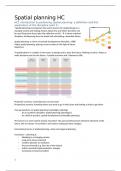College aantekeningen
Samenvatting alle hoorcolleges Spatial Planning 2024
- Vak
- Going Dutch
- Instelling
- Universiteit Utrecht (UU)
Samenvatting van alle hoorcolleges van het SGPL Sociale Geografie en Planologie vak Spatial Planning, geowetenschappen. Het belangrijkste onderwerp is The Planning Triangle, bestaande uit Object planning, Process planning en Context planning.
[Meer zien]




